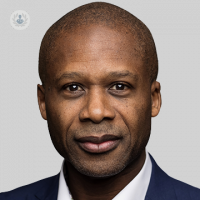Squint: a clear and straight-forward look at the condition
Written in association with:Many people would associate the word ‘squint’ with trying to read something that’s far away, like a television or a sign. Medically, a squint is something different. Esteemed consultant ophthalmic surgeon, Mr Danny Morrison shares his expertise on the condition. The London-based consultant outlines the causes, side effects, and treatment options.

What is a squint? What causes it?
A squint occurs when the eyes are not in parallel and lined up (aligned) correctly. Another word used for this condition is strabismus. Squints can appear in the first few months of life, so-called congenital or early-onset, or later in life.
There are many different types of squint. Most squints are visible to the naked eye of an observer, but sometimes squints come and go very briefly, called intermittent squints. The eyes will often appear to point in different directions, or one eye can appear to move more slowly than the other. The position of one or both eyes will look odd, sometimes turned towards or away from the nose. These types of squints are called esotropias (inwards) or exotropias (outwards drift). Squints can also be vertical, when the eye muscles cause an eye to drift upwards or downwards, relative to the other eye.
Squints have many causes, and in most children (and some adults) a cause cannot be found. Common causes of squints include difficulties with focusing the eyes, or an imbalance of the eye muscles when the muscle pulling on the eyeball is weak. Less common causes of strabismus are injuries to the muscle or nerve that originates from the brain and supplies the eyeball.
Squints (strabismus) are not the same thing as a 'lazy eye', although some individuals with squints can also have a lazy eye (amblyopia). Squints are sometimes, but not usually, associated with and more commonly occur in general childhood illness, clinical genetic syndromes, or developmental issues.
At what age does a squint typically develop?
Squints can develop in some children as early as the first 3 to 6 months of life, but in most children and adults they will appear later, ranging from before the age of five right into adulthood. Childhood-onset squints have different features from adult squints, and the differences can usually be worked out by a detailed history and clinical examination by an orthoptist and an ophthalmologist.
Can it cause any problems with sight or any other side effects?
Squints can cause many problems usually related to the type of squint (horizontal or vertical), when they start, and how long the squint has been present. For some individuals, there can be temporary or constant double vision, trouble focusing the eyes when looking into the distance, or difficulties reading things close-up. Squints can also cause 'eye strain' as the subject attempts to hold the split images together. Some squints cause the individual to tilt the head towards one shoulder, or turn the face towards one side. Squints can, in many children, cause visual acuity meaning the vision is reduced in one or both eyes. Other effects of a squint include a change in appearance, with the squint giving the impression that the affected individual is daydreaming or not paying attention to the listener or observer, due to an apparent lack of eye contact.
How is it treated?
Many squints are treated with observation for a period of weeks or months before any formal treatment is started. Sometimes, however, treatment is started at the first visit, as soon as the squint is diagnosed.
Every child that presents with a squint must have an orthoptic assessment to check vision and eye movements, plus a thorough eye exam and a glasses check (refraction). Treatments for squinting may include constant wearing of glasses to correct any vision or focusing issues, patching one eye for a few hours a day to improve the vision, and orthoptic exercises to help convergence in a few cases. Less commonly, a prism is worn in the glasses to help with double vision. Very rarely, blood tests or scans of the brain or orbits (MRI) are needed. This is usually for rare or unusual types of squint that have suddenly appeared without an obvious cause.
Can surgery be used to treat a squint?
A good number of squints are treated with surgery to alter the position of the muscles of the eye or to tighten or loosen the muscles that are incorrectly positioning the eye or causing the eye to turn in, out, upwards, or downwards. Squint surgery is always under general anaesthetic in children, and this is also the case in most adults.
Squint operations generally have a high rate of success, although this does very much depend on the particular type of squint. Typically, one squint operation is sufficient to correct a squint in about 80% of individuals. Most squint operations take about one hour, and may or may not involve operating on both eyes. Squint 'surgery' also includes the injection of Botulinum toxin (Botox) into an eye muscle or group of muscles. Botox may be a temporary or a permanent fix, but only in very specific types of squint. Sometimes, surgery on eye muscles is combined with Botox.
If you would like to find out more about squints and would like to book a consultation with Mr Danny Morrison, do so by visiting his Top Doctors profile.


